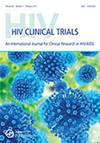接受第一次抗逆转录病毒治疗的患者发生病毒血症的时间和随后的耐药性概况
Q2 Medicine
引用次数: 1
摘要
背景:在现代治疗时代,社区诊所尚未对病毒血症后接受一线抗逆转录病毒治疗(ART)方案的患者的耐药性进行很好的研究。目的:了解病毒血症患者出现病毒血症的时间及抗逆转录病毒药物耐药性。方法:回顾性分析2006年1月1日至2012年12月31日期间,年龄≥16岁且接受三药联合治疗的hiv阳性患者。该方案是两种核苷类逆转录酶抑制剂(NRTIs)和第三种药物:蛋白酶抑制剂(PI),非核苷类逆转录酶抑制剂(NNRTI)或整合酶抑制剂(II)的主干。使用比例风险模型比较病毒血症时间,调整人口统计学和临床因素。对基线和随访基因型的耐药谱进行了描述。结果:653例患者中,使用第三方药物和病毒血症的分布为:PIs患者244例(37%),病毒血症80例;nnrti患者364例(56%),病毒血症84例;II患者45例(7%),病毒血症11例。仅在nnrti中,CD4计数≥200细胞/mm3的患者出现病毒血症的时间长于pi (p = 0.04)。175例病毒血症患者中,143例(82%)有基线,37例(21%)有随访基因型。在病毒血症方面,出现抗逆转录病毒药物耐药性是罕见的。一种新的NNRTI (Y181C)突变被鉴定出来,三名接受pi方案的患者发生了NRTI突变(M184 V, M184I和T215Y)。结论:nnrti患者出现病毒血症的时间较pi患者长。在病毒血症中,如果没有PI或II突变,抗逆转录病毒药物耐药性很少发生,但在以PI为基础的治疗方案中有少量NRTI突变,而在以NNRTI为基础的治疗方案中有少量NNRTI突变。本文章由计算机程序翻译,如有差异,请以英文原文为准。
Time to Viremia for Patients Taking their First Antiretroviral Regimen and the Subsequent Resistance Profiles
Background: The resistance profiles for patients on first-line antiretroviral therapy (ART) regimens after viremia have not been well studied in community clinic settings in the modern treatment era. Objective: To determine time to viremia and the ART resistance profiles of viremic patients. Methods: HIV-positive patients aged ≥16 years initiating a three-drug regimen were retrospectively identified from 01/01/06 to 12/31/12. The regimens were a backbone of two nucleoside reverse transcriptase inhibitors (NRTIs) and a third agent: a protease inhibitor (PI), non-nucleoside reverse transcriptase inhibitor (NNRTI), or an integrase inhibitor (II). Time to viremia was compared using a proportional hazards model, adjusting for demographic and clinical factors. Resistance profiles were described in those with baseline and follow-up genotypes. Results: For 653 patients, distribution of third-agent use and viremia was: 244 (37%) on PIs with 80 viremia, 364 (56%) on NNRTIs with 84 viremia, and 45 (7%) on II with 11 viremia. Only for NNRTIs, time to viremia was longer than PIs (p = 0.04) for patients with a CD4 count ≥200 cells/mm3. Of the 175 with viremia, 143 (82%) had baseline and 37 (21%) had follow-up genotype. Upon viremia, emerging ART resistance was rare. One new NNRTI (Y181C) mutation was identified and three patients taking PI-based regimens developed NRTI mutations (M184 V, M184I, and T215Y). Conclusions: Time to viremia for NNRTIs was longer than PIs. With viremia, ART resistance rarely developed without PI or II mutations, but with a few NRTI mutations in those taking PI-based regimens, and NNRTI mutations in those taking NNRTI-based regimens.
求助全文
通过发布文献求助,成功后即可免费获取论文全文。
去求助
来源期刊

HIV Clinical Trials
医学-传染病学
CiteScore
1.76
自引率
0.00%
发文量
0
审稿时长
>12 weeks
期刊介绍:
HIV Clinical Trials is devoted exclusively to presenting information on the latest developments in HIV/AIDS clinical research. This journal enables readers to obtain the most up-to-date, innovative research from around the world.
 求助内容:
求助内容: 应助结果提醒方式:
应助结果提醒方式:


